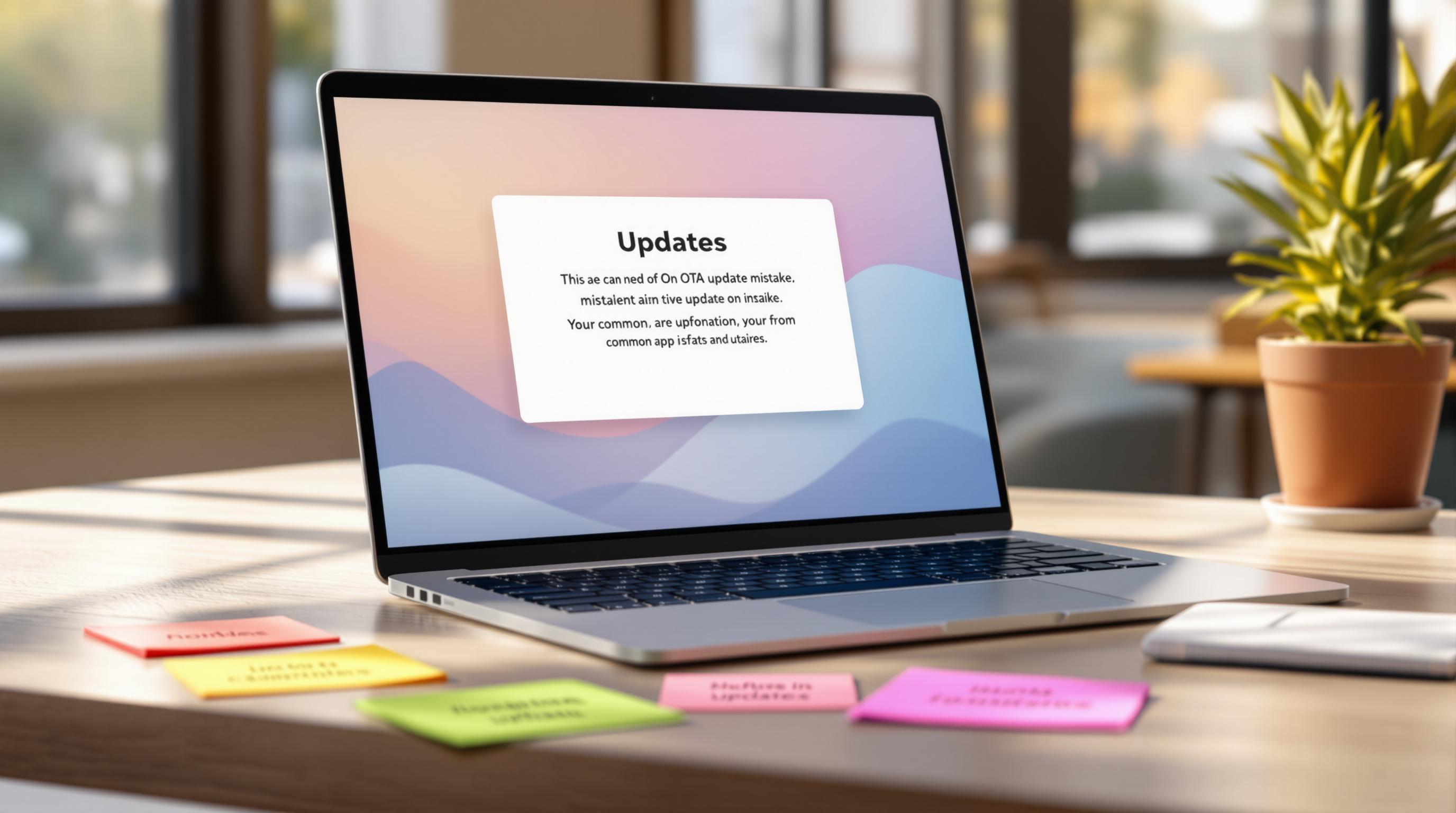Want to update your app quickly without breaking App Store rules? Over-The-Air (OTA) updates let you fix bugs, improve performance, and enhance user experience - all without waiting for app store approvals. But to stay compliant, you must follow strict guidelines from Apple and Google.
Key Takeaways:
- What OTA Updates Do: Push fixes and minor improvements directly to devices without requiring app store downloads.
- Benefits: Faster bug fixes, seamless updates, and cost efficiency.
- App Store Rules:
- Allowed via OTA: Bug fixes, performance updates, minor UI tweaks.
- Requires Store Review: Major features, native code changes.
- How to Stay Compliant:
- Avoid altering core app functionality.
- Use secure delivery methods like HTTPS and digital signatures.
- Clearly communicate update purposes to users.
Quick Comparison of OTA Rules
| Update Type | Allowed OTA | Requires Store Review |
|---|---|---|
| Bug Fixes | Yes | No |
| Performance Updates | Yes | No |
| Minor UI Changes | Limited | Sometimes |
| Major Features | No | Yes |
| Native Code Changes | No | Yes |
OTA Updates and App Store Rules
What OTA Updates Do
OTA (Over-The-Air) updates let developers push fixes and improvements directly to users’ devices without requiring a full app store download. In React Native apps, these updates replace the JavaScript bundle, which handles most of the app’s functionality, while the native code remains untouched [1].
Common uses for OTA updates include:
- Fixing bugs
- Improving performance
- Adjusting UI elements
- Updating content
- Adding minor features
However, staying within app store guidelines is critical to avoid any policy violations.
Following App Store Rules
App stores, especially Apple’s App Store, have strict rules about what can be updated via OTA. Apple enforces tighter restrictions than Google Play, particularly against deploying major features through OTA updates [2]. Here’s a quick breakdown of what’s allowed:
| Update Type | Allowed via OTA | Requires Store Review |
|---|---|---|
| Bug Fixes | Yes | No |
| Performance Updates | Yes | No |
| Minor UI Changes | Limited | Sometimes |
| Major Features | No | Yes |
| Native Code Changes | No | Yes |
Sticking to these rules ensures you can take full advantage of OTA updates without running into compliance issues.
Why OTA Updates Matter
OTA updates are a win for both developers and users. For example, during the 2017 Newport Folk Festival, developers used OTA updates to quickly fix a timezone bug that impacted event schedules [4]. Similarly, Your Call Football used OTA updates to instantly adjust game times when schedules changed [4].
The main advantages include:
- Quick Fixes: Critical problems can be addressed immediately.
- Seamless Updates: Users don’t have to manually download updates; everything happens in the background.
- Faster Iterations: Developers can quickly roll out changes based on user feedback.
These features make OTA updates incredibly useful for maintaining and improving apps in real time.
Can You Perform OTA Updates for iOS Apps? Apple Guidelines Explained
App Store Update Rules
Each platform has its own set of rules for updating apps, and staying compliant is crucial.
Apple’s Update Rules
Apple has a strict review process for both new apps and updates, typically taking 1–2 days for approval [6]. Here are the main requirements:
| Requirement | Description |
|---|---|
| API Usage | Apps must use only public APIs and be compatible with the current OS [3]. |
| Code Execution | Apps cannot download or execute code that alters features or functionality [3]. |
| Update Description | Changes and new features must be clearly explained in the “What’s New” section [3]. |
| Testing | Apps need to be thoroughly tested to ensure stability and fix bugs [3]. |
| Documentation | Provide detailed explanations for features that might not be immediately obvious [3]. |
Apple also uses a secure update system to ensure the integrity of updates, personalize them, and block downgrade attacks [5].
Google Play’s Update Rules

Google Play takes a different approach, relying on automation and AI to speed up its review process. Approvals are often completed within hours [6]. Key aspects include:
- Faster approvals for updates compared to Apple
- More relaxed guidelines
- Open beta testing without requiring prior approval
- A less strict review process for minor updates
Google still enforces security measures and uses automated systems to monitor apps for policy violations [6].
Common Rule Mistakes
Here are common pitfalls to avoid when updating apps:
-
Security Oversights
Failing to verify updates properly can expose vulnerabilities. Always use digital signatures and HTTPS to secure update delivery [7]. -
Feature Overreach
Adding major new features through over-the-air (OTA) updates can violate store policies [8]. -
User Communication
Poor communication about updates can confuse users and weaken security [7].
To stay compliant:
- Regularly audit your update process for security issues.
- Use machine learning to analyze update patterns.
- Clearly explain the purpose of updates to users.
- Avoid altering the app’s core functionality through OTA updates [8].
- Be transparent about subscriptions and pricing details [3].
Following these rules helps ensure your updates meet platform requirements while keeping users happy and informed.
sbb-itb-f9944d2
Setting Up Store-Approved Updates
Set up over-the-air (OTA) updates that meet app store requirements by using secure configurations, thorough testing, and strong security practices.
Technical Setup Steps
Creating app store-compliant OTA updates requires a secure and well-structured technical setup. Here are the key components:
| Setup Component | Requirements | Purpose |
|---|---|---|
| Certificate Management | CSR Generation, Apple Certificate | Ensures secure update delivery |
| Provisioning Profile | Device Selection, Profile Generation | Controls update distribution |
| Update Settings | API Tokens, Team Configuration | Manages update deployment |
| Version Control | Git Repository Integration | Tracks update history |
For enterprise deployments, you can fine-tune update behavior by:
- Setting deferral periods between 1 and 90 days for supervised devices.
- Controlling major version upgrades.
- Scheduling updates during off-peak hours.
After configuration, rigorous testing ensures the updates align with compliance requirements.
“Capgo is an essential tool for developers, boosting productivity by bypassing lengthy review processes for bug fixes.” [9]
Update Testing Steps
Testing is critical to ensure compliance and maintain user satisfaction. Follow these practices for effective testing:
-
Risk Assessment
Build a detailed testing strategy that includes a compliance checklist, vulnerability checks, and user impact analysis. -
Beta Testing Program
Use tools like Apple’s AppleSeed for IT program to test updates systematically. Enroll different device groups in beta programs, roll out updates in phases, and monitor feedback and performance metrics. -
Accessibility Verification
Test updates in real-world scenarios to identify usability issues. For example, addressing prolonged button press issues reduced support tickets by 142% [10].
Update Security Steps
Security measures must meet platform standards and regulatory guidelines. The Apple App Store enforces multiple layers of protection, including:
- Automated malware scans.
- Manual review of update descriptions.
- Verification of sensitive data access.
- Monitoring user feedback for security issues.
“Every single app and each app update is reviewed to evaluate whether it meets requirements for privacy, security, and safety.” - Apple Support [11]
To stay compliant with security standards:
- Incorporate security testing into your development pipeline [12].
- Apply secure-by-design principles.
- Stay updated on regulatory requirements in different regions.
- Document all security protocols and testing procedures.
As of February 27, 2025, Capgo reported delivering 502.0 million updates worldwide, with 1.8K apps using the platform in production [9]. This shows that large-scale OTA updates can be achieved while maintaining strict security and compliance standards.
With security measures in place, the next step is ensuring a smooth update experience for your users.
Capgo: OTA Update Platform

Capgo offers a reliable way to handle app store-compliant over-the-air (OTA) updates, building on the practices mentioned earlier.
Capgo Key Features
Capgo ensures secure and compliant OTA updates with these standout features:
| Feature | Description | Benefit |
|---|---|---|
| Instant Updates | Push changes within minutes | 81% boost in release efficiency [9] |
| End-to-End Encryption | Updates are encrypted and user-specific | Strengthened security |
| CI/CD Integration | Works seamlessly with GitHub, GitLab, Jenkins | Simplifies deployment |
| User Assignment | Control who gets updates | Enables targeted rollouts |
| Version Control | Manage update history easily | Simplifies maintenance |
The platform also ensures compliance and high performance with its custom Dart interpreter [13]. These features make Capgo a dependable choice for adhering to app store policies.
How Capgo Stays Compliant
Capgo maintains strict adherence to app store guidelines by:
- Updating only JavaScript bundles, avoiding native code changes [14].
- Ensuring updates align with the app’s original purpose, do not create new storefronts, and don’t compromise system security.
“Interpreted code may be downloaded to an Application but only so long as such code: (a) does not change the primary purpose of the Application by providing features or functionality that are inconsistent with the intended and advertised purpose of the Application as submitted to the App Store, (b) does not create a store or storefront for other code or applications, and (c) does not bypass signing, sandbox, or other security features of the OS.”
– Apple Developer Program License Agreement [14]
Capgo Plans and Pricing
Capgo offers flexible pricing options to match different needs:
| Plan | Monthly Cost* | Updates/Month | Monthly Active Users |
|---|---|---|---|
| SOLO | $12 | 2,500 | 500 |
| MAKER | $33 | 25,000 | 5,000 |
| TEAM | $83 | 150,000 | 30,000 |
| PAYG | $249 | 1,000,000 | 200,000 |
*Prices reflect annual billing.
Every plan includes priority support, bandwidth, and storage. The PAYG option adds API access, custom domains, and dedicated support.
“We practice agile development and @Capgo is mission-critical in delivering continuously to our users!”
– Rodrigo Mantica [9]
“Capgo is a smart way to make hot code pushes (and not for all the money in the world like with @AppFlow) 🙂”
– NASA’s OSIRIS-REx team [9]
Keeping Users Happy With Updates
Communicating Updates to Users
Clear and professional communication about updates can make a big difference. Here’s how to structure your messages:
- Purpose: “This update boosts app performance and addresses user feedback.”
- Timeline: “The update will take just a few minutes to complete.”
- Requirements: “Ensure you have enough free space and a WiFi connection.”
- Next Steps: “Tap ‘Update Now’ to proceed or schedule it for later.”
Acknowledge user input where possible. For example, Mailchimp’s Product Team shared:
“We heard you and changed things up” - Mailchimp Product Team [16]
This transparent and user-focused approach helps build trust and ensures smoother update adoption.
Managing User Feedback
Handling user comments effectively is essential for improving updates and maintaining satisfaction. Here are some strategies:
-
Real-time Monitoring:
- Track device performance after updates.
- Collect error logs for analysis.
- Keep an eye on in-app user reports.
-
Response Protocol:
- Address reported issues quickly and share timelines for fixes.
- Document feedback to guide future updates.
These steps not only resolve immediate concerns but also inform better planning for future updates.
Timing Your Updates
Choosing the right time for updates is crucial to keep users happy and systems stable. Here’s how to approach it:
-
Usage Analysis:
- Schedule updates during periods of low activity across relevant time zones.
- Plan around natural breaks in user activity.
-
Deployment Strategy:
- Roll out updates to small user groups first.
- Monitor stability before expanding the rollout.
- Allow users to schedule updates at their convenience.
-
Technical Considerations:
- Avoid scheduling updates during peak times.
- Retry failed updates more frequently.
- Check network conditions before initiating updates.
As one update notification puts it:
“A new update for your device is available!” [15]
Striking the right balance between update frequency and timing can help avoid user frustration while keeping security and performance on track.
Conclusion
OTA updates play a key role in modern app development. They allow for quick fixes, easier maintenance, and staying within app store rules. As discussed, managing OTA updates well improves both security and user experience while offering major business advantages.
App store guidelines set the rules for deploying updates, ensuring apps remain secure and reliable. Following these rules has had a huge impact - companies saved over $500 million in 2023 alone through software-based fixes [17].
Developers have shared their success with compliant OTA solutions:
“We practice agile development and @Capgo is mission-critical in delivering continuously to our users!” – Rodrigo Mantica [9]
To succeed with an OTA strategy, focus on:
- Keeping core app functionality intact as approved
- Using non-intrusive background updates
- Monitoring performance and user feedback regularly
- Meeting strict security standards




